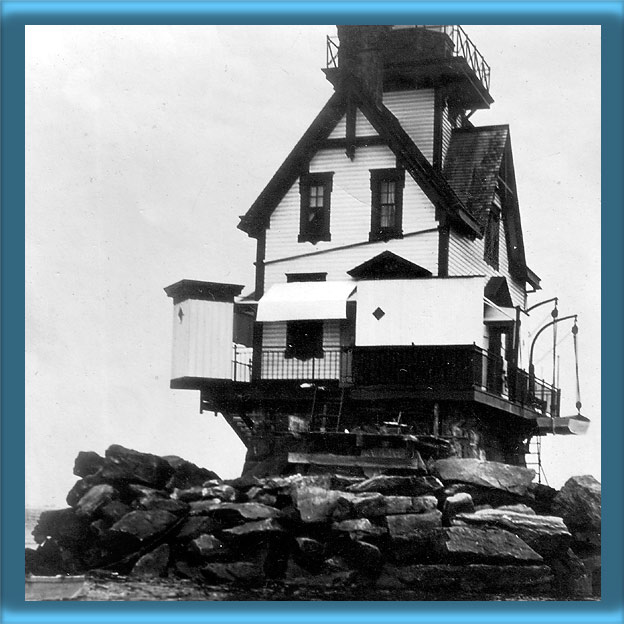Joseph Bowes, the Sabin Point Lighthouse keeper, was also Bullock's Point Lighthouse's keeper for three months. He would leave Sabin Point Lighthouse a few hours before sunset and row a mile and a half down the Providence River to Bullock's Point Light. He would light it and row back to Sabin Point Lighthouse. He would repeat the process in the morning to cut the light off.
In 1873 the Lighthouse Board appointed an assistant keeper at Sabin Point Lighthouse to be Bullock's Point Light's keeper. The first assistant keeper, George Burroughs, served for three months before he was promoted and transferred. The assistant keeper position was offered to two other men, who both turned it down. George W. Doane replaced him in May.
Congress appropriated $15,000 in 1874, to build a permanent lighthouse on Bullock's Point. While the new light was being built, the portable beacon was removed and was replaced with a temporary light on a stake. The lighthouse was completed and lighted in 1876. John Weeden replaced Joseph Bowes as Sabin Point Lighthouse keeper in 1875. He was also listed as Bullock's Points Light's keeper.. He was the keeper in name only. Doane was the actual keeper. The lighthouse board made it legal in 1877, when they appointed him Bullock's Point Lighthouse's keeper.
| Ad for Material to Build Bullock's Point Lighthouse (1875) |
|---|
 |
| New York Times May 10, 1875 |
John J. Card was Bullock's Point Lighthouse's sixth keeper. He served from 1892 to 1901. In late December 1893 he observed an old fisherman, in a small fishing boat, working near the lighthouse for several days. Card was curious about what the fisherman was doing. On December 20, he decided to find out.
The fishing boat was anchored off Bullock's Point near the lighthouse. Card rowed to the fishing boat. The fisherman was lying in his boat. He was barely conscious and hypothermic. One of his hands was frost bitten. Card took him back to Bullock's Point Lighthouse to warm him up.
After he recovered, the fisherman told Card what he was doing. A towing company had put an ad in a local newspaper offering ten dollars for a cable and anchor that fell off one of their barges. The fisherman said, "I saw the piece in the paper, and thought I'd make $10.00. Money is mighty scarce at home and $10.00 would be a Godsend." He stayed at the lighthouse for a couple of days until he recovered. He paid a high price for that $10.00. In a newspaper article Card said, "The man's fingers are badly frozen and it is probable that they will have to be amputated."
On September 21, 1938, one of the most powerful hurricanes in history hit Rhode Island. During it, the light's last keeper, Andrew Zuius would live up to the best traditions of the Lighthouse Service. Hurricane driven wind and waves battered Bullock's Point for hours. Suddenly a huge wave tore away part of one wall. Water poured into the lighthouse. Andrew tried to put a mattress in the hole, but it was no use. Another wave hit and took out the wall on the other side of the lighthouse. Water kept pouring into the lighthouse. Zuius had to go to the light's second floor, so he wouldn't be washed out of the light. Just minutes after he climbed the stairs to the second floor, a huge wave tore them away. Andrew kept the light burning through the night. The next morning someone came out and got him. Even thought the light was wrecked, he continued to tend it, while he lived on shore with his family. Andrew was transferred to Palmer Island Lighthouse in 1939, when Bullock's Point Lighthouse was closed. He retired from the lighthouse service in 1944.
The remains of the Bullock's Point Lighthouse was removed in 1939. It was replaced with a light on a skeleton tower.
| Bullock's Point Lighthouse in 1900 |
|---|
 |
| Courtesy of N.L. Stebbins |
